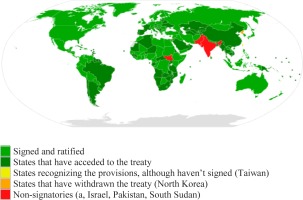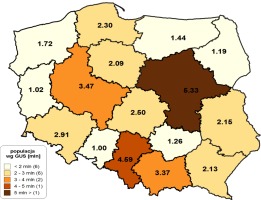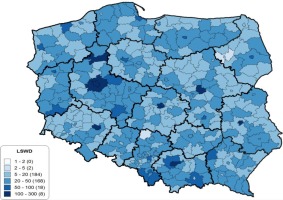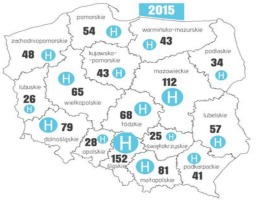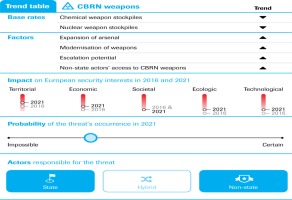Dangers lurk for us then just then, when it seems we are reaching a safe port and we have achieved the desired peace.
Nikolai Vasilyevich Gogol
Introduction
For many years, the threats connected with weapons of mass destruction have been playing a leading part in international politics. The term “weapons of mass destruction (WMD) is used to describe various types of weapon distinguished by two main features: the potential for large-scale destruction and the uncritical nature of their effects, in particular against the civil population. There are three main types of weapons of mass destruction: nuclear weapons, chemical warfare agents and biological weapons. In addition, some analysts also include radiological materials, as well as missile technology and delivery systems, such as airplanes and ballistic missiles. According to one of the definitions, weapons of mass destruction mean tools of combat (complete devices or sets of devices) aimed at mass destruction of people, animals, military equipment and objects deployed in large areas. Some toxic industrial materials (Żuber 2015, p. 11) can also be used as weapons of mass destruction. As long as military actions are always connected with killing people, weapons of mass destruction constitute an unprecedented configuration of challenges to peace and security. Within the last century, various countries developed and accumulated a lethal arsenal of nuclear, chemical and biological weapons together with materials required for their production. While an official commitment was made to eliminate all resources of chemical weapons and offensive biological weapons as well as to strive for eradication of nuclear weapons, which resulted in the signing of the Treaty on the Non-Proliferation of Nuclear Weapons, nine countries still currently possess such weapon, including the UK, China, France, India, Israel, North Korea, Pakistan, Russia and the USA. Figure 1 shows the current involvement of states in the treaty accession process.
Apart from the threats posed by the existing stockpile of weapons of mass destruction, considerable problems emerge from attempts undertaken to proliferate such weapons and the weapon-related technology in additional countries, non-government organisations and terrorist networks through secret programmes and the black-market sale of weapons and technologies. The concerns about WMD use for terrorist purposes increased in the United States and all over the world after the terrorist attacks in September 2001. Only a few days later, between 2nd October and 20th November 2001, 22 cases of bioterrorism connected with the use of anthrax were detected in the USA, including 11 cases identified as inhalational anthrax, while in the remaining 11 cases (7 confirmed and 4 suspected ones), cutaneous anthrax was reported. In March 2002, there was one more incident of cutaneous anthrax, when a laboratory worker was infected while examining and processing environmental samples coming from the previous attack (Center for Disease Control and Prevention, 2002).
Fig. 2
Letter sent in 2001 to the leader of the U.S. Senate majority, Tom Daschle, contained the anthrax powder (www.commons.wikimedia.org)

The above facts were of fundamental importance for the renewed interest in weapons of mass destruction and encouraged discussions about the hazards resulting from the use of WMD, bringing about its redefinition and updating the principles of both American and global security policy. They also contributed to reconsidering ways to prevent WMD use and developing optimal standards of emergency aid for the injured if they are used, as well as building specialist infrastructure and ensuring adequate medical assistance that should be also based on the existing health care systems. According to the adopted definition, a WMD is a chemical, biological, radiological or nuclear weapon capable of high-level destruction or causing mass fatalities (Department of Defense 2015). All four types of WMD offer those wanting to develop and use them specific advantages and disadvantages. Some require a certain level of skills; some need access to controlled or illegal substances, while others involve substantial capital outlays and/ or cooperation with officials on certain security and authority positions. Some WMD types may cause considerable damages and high mortality, while the biggest results of others will consist in inspiring and spreading a state of panic, with subsequent high costs of regaining normalisation. Nevertheless, all players involved in this field remain indisputably aware that any critical situation resulting from the use of any WMD type requires a complex approach to the liquidation of its all effects. While according to the binding guidelines, hospitals located nearest to an incident are obliged to provide medical aid to the most heavily injured, the professional assistance and protection of other victims of the potential attack constitute a serious challenge, in both specialist and logistic aspects. The difficulties are increased by the necessity to diversify the assistance that is provided depending on the type of WMD used. It seems therefore justified to provide details of each type of weapon and afterwards, the system of primary health care, in order to focus on indicating the role of the basic health care system and the way it can be adequately involved in a critical situation.
Types of mass destruction weapon
Chemical and biological weapons
Due to their extraordinary action, both chemical and biological weapons have been arousing huge interest for many years, despite the existing ban on their use. The chemical weapon employs the toxic features of chemicals capable of causing damages, including death. A relatively small amount of chemical agents is sufficient enough to achieve considerable physical and psychological effects. From the historical viewpoint, the chemical weapon was the most frequently and commonly used WMD type; however, it received much less attention than either biological or nuclear weapons. Unlike other WMD types, the technique of chemical attacks changed only slightly within the last 50 years. Perhaps the most significant occurrence is connected with more and more advanced and accessible production plants and enhanced methods of chemical agent diffusion (usually by means of explosives and aerosols). The most frequently used supply systems include artillery missiles, bombs, spray tanks, missiles, rockets, grenades and mines. Other distribution methods, such as plant-spraying planes, pesticide fogging machines and aerosol spraying devices, have also been developed. The chemical weapon was used for the first time by the Germans during the First World War. The toxic agents used in this conflict caused about 100,000 deaths and over 1 million injured. During the Second World War, Nazi Germany developed and manufactured large amounts of newly discovered agents influencing the neural system, but they refrained from using them against the allied forces. On the other hand, the insecticide Zyklon B was successfully used to kill people in concentration camps. Nearly 20 years later, during the war in Vietnam, the United States applied a defoliant (although defined rather as a herbicide, not chemical weapon) named Agent Orange that contained dioxins being the carcinogenic agent. After another 20 years, at the beginning of 1984, an investigative team of the United Nations found that Iraq used chemical weapons in the Iraq-Iran War, and at least some of the chemical precursors and materials were purchased through legal trade channels. In 1987, Libya employed a chemical weapon against Chad troops. In 1988, Iraq conducted chemical attacks killing about 100,000 Kurds. In the next decades there were several incidents where a chemical weapon was employed for criminal and terrorist purposes, including the most significant attack by the Japanese group Aum Shinrikyo. In 1995, its members used Sarin in the Tokyo underground attack resulting in 12 fatalities and 5,000 injured (Nuclear Threat Initiative 2015). The biological weapon utilises microorganisms and natural toxins for causing illnesses that affect humans, animals or plants. Of course, in order to act as a weapon, pathogens needs a means of transportation; their supply through bombs or missiles is possible, but not necessary. A conflict party or a terrorist group may contaminate food or water, use insects or aerosols to disseminate the given pathogen. The biological weapon is considered the most lethal type ever made. Microbes don’t respect any borders meaning that the biological threats, both caused by mankind and occurring naturally may promptly exert a global influence. Although only a few countries are suspected of possessing any biological weapons, it is surprisingly easy and doesn’t take long to manufacture and weaponise biological agents. Furthermore, it is difficult to distinguish between legal and harmful biological research projects. Scientific progress offers an extraordinary promise of new methods of treating illnesses, but the same knowledge and equipment can be used to develop deadly pathogens. The fast growth in the field of biotechnology means that the pharmaceutical and medical industries in most countries are equipped with both the knowledge and tools to develop biological weapons. Along with the expansion of technology and know-how, as well as the establishment of private laboratories, the risk level has increased, which is reflected in the dangerous laboratory accidents and the involuntary development of so-called ‘super bacteria’ that may get out of control under public health care systems. Among the examples illustrating the possible level of danger in the last years, there are viral haemorrhagic fevers, like Ebola virus disease, turning out to be highly contagious, fatal and enormously challenging for contemporary medicine. What also matters is the fact that chemical and biological weapons are easier to acquire in the financial and logistical aspects, as compared to radiological or nuclear weapons. They also cause smaller infrastructural losses; however, they have a much greater psychological impact than conventional weapons. Furthermore, the chemical weapon is relatively simpler for terrorist groups or even individuals to manufacture. The knowledge regarding how to produce it is easily accessible; many chemical precursors can be legally used and are legally available. The analyses indicate that in some countries the security measures connected with chemicals are weak and the equipment used for chemical production is widely accessible (Jenny and Limage 2018).
Radiological and nuclear weapons
The radiological weapon as a WMD type appeared within the last 30 years and was connected with the terrorist threat (Żuber 2015, p. 43). It constitutes a means of combat where the destructive factor is a dispersed radioactive material that can be obtained from both units implementing nuclear programmes and nuclear waste coming from reactors or radioactive agents used in the industry or medicine. Radioactive dispersal devices, known as ‘dirty bombs’, represent the solution applied by the radiological weapon in the field. They disseminate radioactive materials resulting in the contamination of local areas and, consequently, make normal existence in the polluted locations impossible, as well as delay or hinder operational activities. For the purpose of a potential attack, the spreading method can be applied in a way extending the area of contamination, for example with the use of explosions, direct spraying, dispersion of particulates, spillage of liquids or formation of aerosol. The radioactive dispersal devices are considered by experts as more likely to be used by terrorists, as their production requires minor skills when compared to conventional bombs and their components are easier to acquire. They allow the radioactive materials to spread and take effect instantly, unlike the nuclear facility that produces radiation only when it explodes. They don’t cause such substantial losses in the infrastructure; however, they play a considerable role in feeding the fear of radiation within society, causing widespread panic and disarray that are often a real target of terrorist groups. Out of all WMD types, the nuclear weapon has the most destructive power. It is notable for the enormous level of energy emitted during an uncontrolled chain reaction, which is either the fission of heavy element nuclei or the thermonuclear synthesis of hydrogen isotopes. Depending on the type of the reaction following the detonation, nuclear weapons have been divided into atomic and thermonuclear, but there is no difference in their destructive effects. The huge power and devastating effects of a nuclear explosion result from the fact that inside the small-sized nuclear load, a huge amount of intranuclear energy is emitted within several millionths of a second in the form of kinetic energy, excitation energy and neutron energy. The direct effects of the explosion include: shockwave, thermal radiation, ionizing radiation and electromagnetic pulse, while radioactive contamination occurs as a delayed consequence. The above mentioned effects threaten life and health and influence the technical infrastructure. Considering the possible use of a nuclear weapon by terrorist groups, it can be stated that although its construction is complex, the skills required for manufacturing, as well as the financial and logistical support required for obtaining materials, manufacturing and transportation pose an obstacle (Weiss 2015), the potential damage and mass mortality may still be encouraging. As shown above, the impact of radiological and nuclear weapons, apart from the instant death of the injured and huge destruction, brings about severe remote consequences in the form of radioactive contamination. Thus, in the case of radiation, the dose is of crucial importance, as well as the duration and intensity of exposure (whether it is slow and long-lasting or large and immediate). The radiation affects those cells of a human body that are subject to active fission. Such cells are among others located in the hair, alimentary canal, bone marrow and reproductive organs. A big and rapid dose of radiation results in cell death and the effects are visible within several hours, days or weeks. A lower and prolonged radiation dose doesn’t cause instant cellular damage, while the changes can appear slowly and become clinically detectable at the late stage. Furthermore, they can be transmitted by mutated or damaged genes. One of the most severe, long-lasting delayed effects of radiation exposure is a significant increase in the prevalence of leukaemia, thyroid cancer, breast cancer and bone cancer. In the context of the mentioned health consequences resulting from the use of such weapon, it seems reasonable to remember that the world’s number of nuclear warheads, estimated at the end of 2017, is 14,900. It accounts for less than a half of the arsenal existing in the peak time of the Cold War. Such warheads are nowadays owned by nine countries (Kristensen and Norris 2017) and each of them has twenty times as much average explosive power as the nuclear weapon that destroyed Japan’s Hiroshima and Nagasaki killing several hundred thousands of people. Since 1945, no nuclear weapon has been used in any conflict, although it was at the disposal of warring parties and about 100 wars were waged over nearly 60 years. Due to the fact that it has been part of state-owned arsenals for more than half of a century, there is still a proclivity among politicians towards the silent acceptance of nuclear weapon and it remains the crucial element of political pressure.
Primary health care as the universal tool for responding to WMD threats
The basic health care system
When a critical situation posing a threat to public health occurs, in order to cope with the increased health care needs and solve the problem of lacking resources, the medical care standards may require an adjustment justified by the redirection of medical care from individual to collective. This is because one of the basic elements included in the WMD definition refers to the mass destruction of people. Producing such effect requires selecting the location of the biggest population centres. According to the Central Statistical Office (GUS) data, Poland’s population was nearly 38.5 million in 2017 (Główny Urząd Statystyczny 2017). The most populated voivodships are Mazowieckie (13.9%) and Śląskie (11.9%), while the smallest proportion of inhabitants reside in Opolskie (2.6%) and Lubuskie (2.7%) voivodships. Detailed data on the population of Poland by voivodship is provided in the figure below.
Pointing at the importance of the primary health care (POZ) in case any critical situation occurs, it seems essential to indicate that it constitutes the part of the health care system with the highest reach, providing all those entitled to benefits residing or staying on the territory of Poland with comprehensive and coordinated medical services in the place of their residence. Services are provided on an outpatient basis (doctor’s consulting room, clinic or health centre), and in medically justified cases also at the patient’s home. The POZ functioning is based on the patient’s right to make a nominal choice of a primary care doctor, a nurse and a midwife. Apart from so-called ’first-contact’ physicians in some primary health care centres, medical consultants in outpatient specialist care are also employed. Along with other medical staff, they constitute a specialist potential available for use in a critical situation resulting from a WMD attack. It is also important that the system is ready for action with no additional, specific financial outlays required for its launch. The basic health care, except services provided at night and during holidays, is financed through annual rates per capita, on the basis of patients’ registers. Operating jointly, the primary health care units cover the territory of the entire country and are thoroughly identified by the population residing in a given area where there is no problem reaching them. These facts are crucial for the possibility of system application in the occurrence of a critical situation. The number of service providers (primary health care centres) is shown in the figure below.
The detailed data on the structure of the primary health care and specialist outpatient care, illustrated with the number of clinics and doctor’s practices is shown in Fig. 5.
Fig. 5
Number of health centres and doctor’s practices by voivodship in 2017 (Narodowy Fundusz Zdrowia 2017)
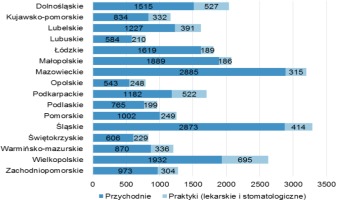
Comparing the quantitative potential of the primary health care with the number of general hospitals, which in the event of an attack might serve as an evacuation destination for those most injured, it should be pointed out that the basic health care system seems to be an interesting professional-level tool to support potential victims of WMD use at the first stage. Figure 6 illustrates the number of general hospitals in voivodships.
Tasks of the primary health care system after WMD use
Despite the necessity of diversifying aid to be provided according to the type of WMD used, the existing general standards of medical support allow the manner of adequate POZ involvement in a critical situation to be determined. It is beyond all doubt that thanks to its appropriate human and equipment potential, it shouldn’t pose a problem for the primary health care units to undertake actions aimed at reducing (possibly eliminating) the consequences of injuries and illnesses occurring after WMD usage that are directly life-threatening. They should also be able to prevent the emergence of dangerous complications (such as hypoxia, shock, and infection) or downsize their heaviness and prepare for further evacuation from the attacked area. Medical services provided at the stage of pre-hospital first aid perfectly fit the tasks performed by the basic health care. Taking into account the already mentioned wide availability of POZ units and consequently their ability to ensure the optimal time for the first medical aid that is between 30 and 60 minutes since the occurrence of a critical situation (Eisele 2008, p. 1), it can be assumed that the injured should find their way to these centres. Obviously, this type of care has to be provided together with categorising casualties depending on the level of injuries and medical prognosis, and the latter can also be conducted by qualified POZ personnel. During a mass incident (such as WMD use) causing a considerable number of injured approaching the pre-hospital stage, it is not possible to provide all those in need with the full-range of medical assistance within an acceptable timeframe. Under such circumstances, the medical first aid operations should be classified (depending on how fast they are provided) into two groups: immediate (prompt) actions and postponed actions, which can be provided at the next stage. At this point, a new opportunity appears. On the basis of the existing employment structure of POZ units that can be optimised in a crisis situation, the latter group (i.e. the injured qualified for later assistance) can be successfully handled by other qualified medical personnel. It should be pointed out that disregard of the above mentioned division into groups threatens the attack victims’ death or at least the high probability of serious health complications. A special role can be played by the POZ system if a biological weapon is used asa destructive agent. While a chemical or nuclear weapon attack leads to visible consequences, a biological attack is more subtle, so many people may not even know that they have been infected and become its victims. Instead, they may approach medical centres complaining about certain symptoms, whereas illnesses caused by the use of biological weapons can be confused with other disorders, because the accompanying occurrence of coughing, torsions, fever or rash are non-specific symptoms. The professional care provided by POZ physicians who know the previous health problems of their patients is likely to result in proper diagnosis of the difference without waiting for the occurrence of public information, confirming that sick people in a given area were affected by a biological attack. Contrary to the use of biological weapons, a chemical attack hits instantly. The injured demonstrate dramatic symptoms, including extreme dyspnoea, weakness of muscles, convulsions or total loss of consciousness. Due to time playing a crucial role in treating a chemical attack and the accompanying dramatic reactions, potential victims may reach medical institutions located nearest to the contaminated site, most likely the POZ centres. Still, in these cases, it is necessary for medical personnel to introduce suitable corrections in the routine procedures. It is perfectly illustrated by the example of behaviour following the diagnosis of cardiorespiratory failure. The staff may instinctively begin mouth-to-mouth resuscitation, which is likely to result in the absorption of the toxic agent. Hence, unfortunately, apart from the development of provisional areas of contamination (also by potential patients) and contamination-free areas or the possible provision of specialist transportation means (if owned by a given centre), the delivery of aid by the POZ system can hardly be possible without the support of specialist rescue units providing decontamination, among other things. Above all, a nuclear, radiological attack with the use of a so-called ’dirty bomb’ consisting of a conventional explosive wrapped in the radioactive material carries the risk of instant death, but also brings about two major health problems: very high trauma level and radiation. The conventional explosives are responsible for the majority of injuries and deaths after the use of ‘dirty bombs’. The radiation induced by them may cause serious illnesses and deaths, and in the longer run, result in the increased risk of cancer. First of all, however, they provoke huge panic among civilians. The task for the primary health care in this case, therefore, should focus on diagnosing and treating injuries, as well as implementing radioactive contamination prevention. Regardless of the type of hazard resulting from the WMD used for the attack, it is necessary for all health care units to maintain a working communication system guaranteeing the flow of information between managerial and operational centres.
Conclusions
Chemical biological, radiological and nuclear weapons constitute various challenges for international peace and security. The research into weapons of mass destruction conducted in the past and at the beginning of the 21st century has been constantly trying to conclude with future efforts targeted at handling the persisting political and strategic challenges posed by such weapons. The most powerful international players will most probably still perceive chemical, biological, radiological and nuclear weapons as the potential devices to expand their interests. Considering the fast growth of terrorist organisations and their methodical search for new and threatening instruments of exercising pressure, they will remain actively interested in gaining weapons of mass destruction. Consequently, the global threat resulting from WMD use is likely to increase. This is confirmed by the assessment of the WMD-related hazards up to 2021 (Meer 2017, p. 3), developed by the Netherlands Institute of International Relations on the basis of a range of selected indicators. It is shown in Table 1.
It was found that a minor, but worrying increase of WMD-related hazards can be expected. In particular, a major role is played by the following: strains occurring in relations between major powers, a risk of the multilateral Treaty on Non-Proliferation of Nuclear Weapons collapsing and a growing threat posed by non-state entities.
On the basis of the author’s own reflections presented in this article and taking the above mentioned analysis conducted by the Netherlands Institute of International Relations into consideration, it seems justified to conclude that the risk of WMD being used still exists. The use of such weapons may result in a critical situation requiring the involvement of the primary health care system. From this viewpoint, it seems advisable to implement suitable programmes for POZ staff training in order to make them fully prepared to operate in a crisis situation and capable of using the existing potential of the system.
The fast evolving world of both scientific inventions, technological progress and geopolitical changes constituting the key factors in the research focused on weapons of mass destruction, as most likely to encourage experts to analyse opportunities for using contemporary health care systems in a possible crisis situation. The involvement of the primary health care system will require the personnel to be adequately familiar with the effects of WMD use, which in turn will require redefining the conditions of cooperation with experts and institutions that have the professional expertise in these issues. The latter are likely to facilitate the further development and implementation of a better, more universal and modern system of national security.


